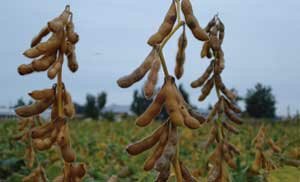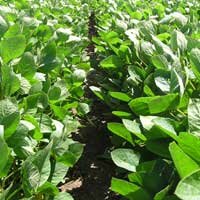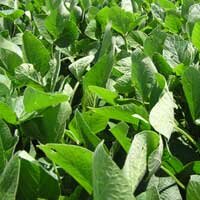
-
Diseases
- Asian Rust
- Anthracnose
- Bacterial Blight
- Bacterial Pustule
- Bean Pod Mottle Virus
- Brown Stem Rot
- Cercospora Leaf Blight
- Charcoal Rot
- Downy Mildew
- Frogeye Leaf Spot
- Green Stem Syndrome
- Iron Deficiency Chlorosis
- Phytophthora Root & Stem Rot
- Powdery Mildew
- Rhizoctonia
- Seedling Diseases
- Septoria (Brown Spot)
- SCN (Soybean Cyst Nematode)
- Soybean Mosaic Virus
- Stem Canker
- Sudden Death Syndrome
- Viruses
- White Mold
- Pests
- Biological Control
- Agronomics
- Diagnostic Tools
- About Us
- Library
Managing Soybean for High Yield
 |
|
Matching soybean varieties to a specific field is the foundation of maximizing soybean yields.
Photo credit: Palle Pedersen, Iowa State University |
Soybean varieties have a maximum yield potential that is genetically determined. However, the actual yield potential for soybean varies considerably with environmental conditions and management decisions.
Agronomic decisions have much greater impact on soybean yield than you might think. Farmers who understand how a soybean plant grows and develops can establish field practices that maximize the genetic potential of the varieties grown. The goal of every management decision should be to provide optimum conditions during specific growth periods that impact yield.
Optimize manageable variables
Management practices that can influence crop growth include variety selection, seedbed preparation, planting rate, planting depth, row width, pest management (diseases, insects, and weeds), fertilization, and harvesting. Producing high-yielding soybeans is achieved by optimizing all these manageable variables and making the right agronomic decisions to reduce stress. Minimizing environmental stress will optimize seed yield.
For example, soybean yield is determined much earlier than most growers realize. A good August rain is not enough to achieve high yields! To achieve yield potential, row closure must be occur before pods begin to set (R3 growth stage) to maximize light interception during the critical pod and seed filling period. Row closure is achieved planting early and in narrow rows by and reducing stress from weeds, insects, and diseases. Early row closure is also critical because it conserves soil moisture.
 |
 |
| Spacing rows less than 30 inches promotes high yield by making the best use of the sun’s heat and light in northern climates. Photo credit: Chris Boerboom, University of Wisconsin |
Seven steps to achieving high soybean yield
1. Variety selection. Producers must select high-yielding varieties with agronomic traits that match the ever-changing stresses in each field. For example, today’s monoculture system of soybean/corn rotation has led to more disease pressure for both crops.
2. Manage soybean cyst nematodes (SCN). SCN is often the greatest limiting pathogen in soybean fields in the North Central region. The best management practice is to rotate high-yielding SCN resistant varieties with a non-host crop such as corn.
3. Plant early if seedbed conditions are satisfactory.
4. Plant in rows less than 30-inches. Soybean rows need to close quickly to improve light interception. Increased light interception is essential to promote rapid growth beginning at flowering.
5. Manage weeds early to promote early canopy development. Soybeans are sensitive to early-season competition from weeds, which reduce canopy development.
6. Scout for insects. By scouting weekly, population densities can be managed at economic thresholds using integrated pest management strategies. Pay particular attention to bean leaf beetles and soybean aphids. Also use scouting to plan for next year’s crop by identifying yield-limiting factors during the growing season.
7. Maintain soil fertility. Soil fertility tests should be conducted at least every other year to verify that appropriate fertility levels are maintained. The best time to sample soil is in the fall. Consider taking soil samples to assess SCN population densities at the same time.
Resources
Yields II Project - North Central Soybean Research Program
Manage Soybean “By the Numbers” for Higher Yield - NCSRP Yields II project
Soybean Growth and Management Quick Guide - North Dakota State University (pdf)

